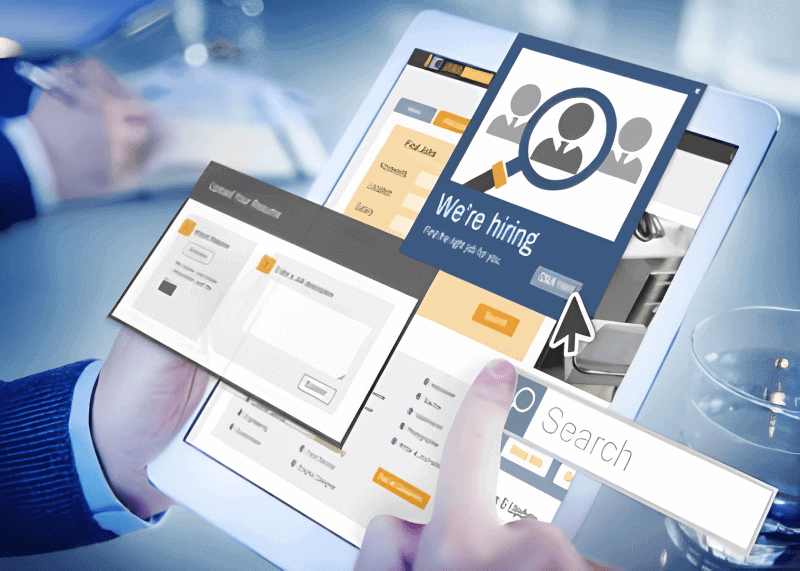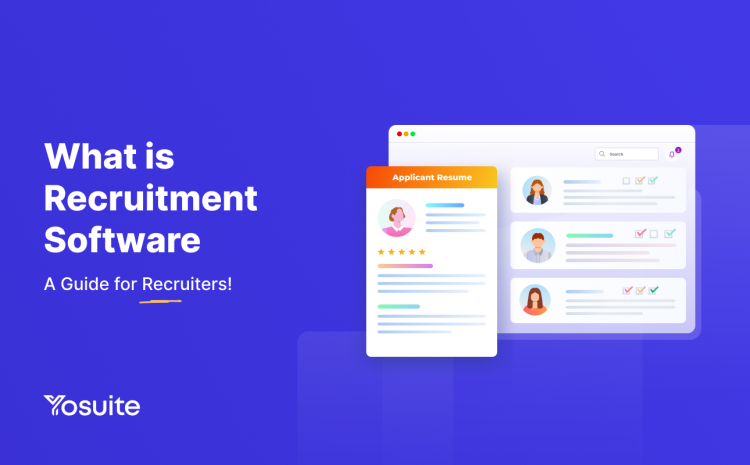Imagine yourself with only a paper map and a telescope. You’re sailing a boundless ocean, full of untapped talents. Doesn’t that seem daunting?
That was recruitment in the past. It was an exhausting process! We sorted through applications, held countless interviews, and crossed our fingers. However, modern recruitment has made everything easy – from talent scouting up to onboarding. That is the magic brought by recruitment software.
What is a Recruiting Software?

Recruiting software tools are used by recruiters, talent acquisition professionals, and hiring managers. They simplify or automate some part of the recruitment workflow. This covers tasks like finding, picking, vetting, and interviewing potential candidates.
Software for recruiting is more than just a fancy resume organizer these days. It’s an advanced system of features and tools. It’s made to help recruiters at every stage of the hiring process. Recruiters can use it to set goals and find the most precious asset of all: the ideal candidate.
Types of Recruitment Software
Sometimes we ask ourselves, what is the best recruitment software available in the market? Think of recruitment software as a toolbox for talent acquisition, not just a hammer! It’s not just about pounding resumes. It’s about attracting, engaging, and selecting the best talent for your organization.
Here are some key types of tools within this toolbox:
1. Applicant Tracking System
ATS software is designed for use by recruiters and employers. It helps them track candidates throughout the recruiting and hiring process. This software can have simple database capabilities. It can also have a full-service suite of tools. It helps businesses of any size filter, manage, and analyze candidates.
Features include:
- Resume parsing,
- Keyword search,
- Applicant communication tools,
- Interview scheduling,
- reporting, and
- Analytics.
Examples:
- Workday Recruit: Part of a comprehensive HR suite, ideal for large organizations
- BambooHR: Affordable option for small and medium businesses.
2. Talent Sourcing Tools
Sourcing tools aid recruiters in proactively identifying potential hires. The tools search through candidate data and profiles. They help start conversations and gather information. This fosters long-term relationships with potential hires. It improves the recruiting process’ efficacy and efficiency.
Features include:
- Social media recruitment,
- Referral programs,
- Job aggregators,
- Candidate databases,
- Ai-powered sourcing tools.
Examples:
- LinkedIn Recruiter: Powerful platform for sourcing talent on LinkedIn.
- Built In: Connects companies with tech talent through events and community building.
3. Video Interviewing Platforms
A video interview platform is a tool for companies across industries. It simplifies the traditional job interview process. It serves as a one-way screening platform. Recruiters can receive recorded responses from applicants and review them at their convenience.
Features are:
- Interview scheduling,
- Recording,
- Screen sharing,
- Candidate feedback tools, and
- Ai-powered interview analysis.
Examples:
- Zoom: Familiar and easy to use for both recruiters and candidates.
- HireVue: Ai-powered platform that analyzes video interviews for insights.
4. Diversity Equity and Inclusion Tools
These resources support businesses in encouraging inclusivity and diversity in the workplace. They provide data-driven insights. They promote diverse candidate sourcing, eliminate unconscious biases, and automate diversity initiatives. These tools track diversity metrics and monitor progress over time.
Additionally, they automate compliance tracking and reporting for diversity-related laws and regulations.
Features include:
- Unconscious bias training,
- Anonymized resumes,
- Blind recruiting tools,
- Diversity analytics, and
- Inclusive language guides.
Examples:
- Blind Hiring: Tools that remove identifying information from resumes to focus on skills and experience.
- TextRecruit: Mobile-first platform designed to reach diverse talent pools.
5. Recruitment Marketing Tools
Recruitment marketing is the use of strategies and tools by an organization. It happens in the pre-applicant phase of recruiting. This type of tool engages and entices job candidates, as it seeks to highlight the benefits of working for the company. It also seeks to establish a corporate culture or brand to attract candidates.
Some features are:
- Employer branding website creation,
- Social media recruitment tools,
- Career page optimization,
- Employee testimonials, and
- Job advertising management.
Examples:
- Jobvite: Create engaging employer branding campaigns and job postings.
- Recruitics: Automate social media recruitment and track applicant engagement.
How Does Recruiting Software Work?
Recruitment software is made to streamline the hiring process. It does this by gathering and organizing data about potential candidates. The data is used to find the best candidates for specific roles.
The process starts with the company inputting details about the open positions and the qualifications. After that, the software scans various channels to find info on potential candidates. These channels include job boards, social media, and resume databases.
Once the data is collected, the software uses Ai and machine learning to pinpoint candidates that best fit the requirements.
Recruiting software functions as:
- Sourcing: Actively publicizing available positions through job postings, career websites, talent communities, and social media platforms.
- Applicant Tracking: Systematically overseeing the applicant workflow, encompassing tasks like resume screening, assessment, interviews, and background checks.
- Recruiting Analytics: Utilizing a comprehensive dashboard to report on key performance indicators (KPIs) and funnel metrics, including metrics such as time to fill, source of hire, and applicant-to-interview ratio.
- Pre-hire Assessment and Background Checking: Conducting evaluations like personality assessments, cognitive and skills testing, and thorough reference and background checks before making hiring decisions.
- Onboarding: Providing training and orientation for seamless integration of new hires into the organization.
Benefits of Recruitment Software in Talent Acquisition
Recruiting isn’t just about filling open positions. It’s about finding the perfect fit who can contribute to your company’s success. That’s where recruitment software comes in. It’s like a digital superpower for your talent acquisition team. This software helps you land the best talent.
Here are some key benefits:
- Reduced time to hire
- Better retention rates
- Enhanced candidate experience
- Deeper pool of qualified candidates
- Future-facing pool of talent
- Increased ethnic diversity of candidates
- Easier collaboration
- Speedier job postings
- Greater focus on skills
………and so on.
Recruitment Software vs ATS vs Recruiting CRM — Know the Difference!
Recruitment software is a general term covering a broad spectrum of tools. ATS and Recruiting CRM are more specialized. They focus on specific aspects of the hiring process. Organizations often use a combination of these tools to meet their unique recruitment needs.
Let’s point out their key differences:
➡️ Recruitment Software:
- Can include ATS, CRM, onboarding tools, interview scheduling, and analytics platforms.
- Offers a wider range of features compared to ATS or CRM alone.
- Useful for companies with complex or diverse recruiting needs.
➡️ ATS (Applicant Tracking System):
- Focuses on streamlining the application and hiring process.
- Manages job postings, resumes, interview scheduling, and workflow automation.
- Helps screen and rank candidates, send interview invitations, and track progress.
- Ideal for high-volume recruitment with many applicants.
➡️ Recruiting CRM (Candidate Relationship Management):
- Focuses on establishing and fostering connections with both present and potential talent.
- Creates and manages talent pools, stores candidate information, and tracks interactions.
- Enables personalized communication, targeted outreach, and engagement campaigns.
- Useful for companies seeking to attract and retain top talent in a competitive market.
FAQs: What is Recruitment Software
1. How does recruitment software improve time efficiency?
Recruitment software automates manual tasks. As a result, less time is spent on administrative tasks. It also enables recruiters to focus on strategic aspects.
2. What types of organizations benefit from specialized recruitment solutions?
Smaller businesses often find value in specialized solutions. These solutions are tailored to their simpler and more specific recruitment needs.
3. Is user adoption a significant challenge in implementing recruitment software?
Yes, overcoming resistance to change is crucial to successful user adoption. Ensuring proper training is also crucial.
4. How can I implement recruitment software successfully?
- Define your needs and goals.
- Research and compare different options.
- Involve key stakeholders in the selection process.
- Provide adequate training for users.
- Start with a pilot project and refine based on feedback.
5. What makes a good recruiting software?
A good recruiting software simplifies and improves the entire hiring process for businesses, making it more efficient and effective. The following are some essential features to search for:
- Core Functionality – ATS, Job Board Management, and Candidate Sourcing Tools.
- Efficiency and Automation – Automated Workflows, Bulk Actions, and Resume Parsing
- Collaboration and Communication – Hiring Team Collaboration, CRM, and Interview. Scheduling.
- Advanced Features – Mobile Recruiting, Skill Assessments, Reporting and Analytics, and Security and Compliance.
6. How can I ensure my recruitment software is compliant with data privacy regulations?
7. How is Ai used in recruitment?
Ai is increasingly being used in various aspects of the recruitment process. It simplifies and enhances efficiency.
- Resume screening
- Chatbot for initial interaction
- Candidate matching and so on….
📍📍📍 Check out these resources↙️↙️↙️:
How can HR Software Help your Business to Grow
How is HR Software Used in an Organization: Things to Know!
How Much Do Companies Spend on HR Software: Expense vs ROI
Final Thoughts
Recruitment software is not a magic wand, but it is a powerful tool that can make a recruiter’s life much easier and more effective. Recruiters can navigate the talent ocean with confidence. They can do this by embracing digital tools and refining their strategies. They know they have the tools and knowledge to find the perfect treasure for their organization.
So, set your sails, recruiters. The vast ocean of talent awaits, and with the right recruitment software as your compass, you’re sure to chart a course to success.



Leave a Reply